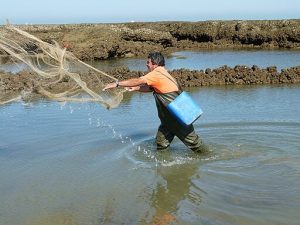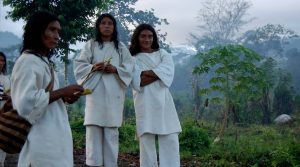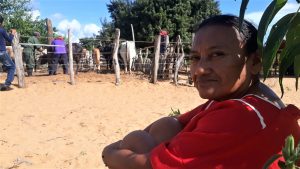5 The magic in everyday life in Colombian cumbia
Cumbia originated en la costa caribe de Colombia as a mixture of música africana, indígena e hispánica. La música original de la cumbia es multi-layered beats of drums, with one leading female voice as cantaora and a choir that repeats what she says. There’s one instrument called guacharaca or raspa, a piece of wood with rough surface that you make sound with a stick. It sometimes has a type of flute similar to the pipe that is called gaita, the Creole version of a similar system of Scottish pipes. The dance is made to enjoy it at a night at the beach.
Common topics of Colombian cumbia include:
- El pescador (=the fisherman)
- La Navidad (=the Christmas) y el año nuevo (=the new year)
- The human animal
El pescador
An important theme of Colombian cumbia is all related to fishing, creating the idea of the marvel of the poor pescador who deals with the supernatural elements of nature. Hay una canción que se llama “El pescador” in the voice of Totó la Momposina, and written by José Barros.
Totó La Momposina – El Pescador (live at Real World Studios)
In any culture where pesca exists, someone has felt the loneliness of fishing. Solo existes tú con los elementos de la natuarleza, en silencio para no asustar al pez. You’re basically thrown into the random fortune of getting fish. La corriente sube (=the water current fills up) with chinchorro and atarraya, names for traditional fishing nets.

The canoa made of the traditional material called bareque or bahareque is ready para llegar a la playa=to arrive to the beach. El pescador then habla con la luna y con la playa, doesn’t have fortuna, just atarraya. La fortuna refers to the good luck, but may also be a word use to the wealth of someone. The fishermen arrive with a carga (=load) of fish to sell on the pork. Their beloved are waiting for them. Regresan los pescadores=the fishermen return al puerto de sus amores=to the deck of their beloved ones. The word querer=wanting also means love or beloved.
The next part starts on 0:40 from the video:
Coro (=Refrain)
(El pescador) Habla con la luna
(The fisherman) talks with the moon
(El pescador) Habla con la playa
The fisherman talks with the beach
(El pescador) No tiene fortuna
The fisherman doesn’t have fortune
Solo su atarraya (X2)
Just his fishing net
Segunda estrofa (=Second stanza)
Regresan los pescadores
The fishermen return
Con su carga pa(ra) vender
With their load to sell
Al puerto de sus amores
To the port of their loves
Donde tienen su querer (X2)
Where (they) have their darling/love.
Songwriters: Jose Barros. Adapted from Musixmatch, powered Microsoft Bing. Non commercial-use only.
- Fishing vocab: pescador (=fisherman), pescadores (=fishermen), chinchorro (=fishing net also used as hammock), atarraya (=larger fishing net), carga (=load), puerto (=port, deck)
- Verbs talking about the fisherman’s routines: habla con (=habla con, talks to/with), tiene (=has)
- Verbs talking about the fishermen’s routines in plural: regresan (=they return), tienen (=they have)
- Verbs in the infinitive: vender (=to sell), querer (=to love, also referred to their darling or beloved person)
- Prepositions: “con” (=with, in “habla con la luna”) and “pa” which is a shortening of “para” (=to, in order to) in “con su carga pa vender” (=with his load to sell)
Gender of “Pescador” is similar to that of “profesor” (=profesor, teacher):
- El pescador: the fisherman
- La pescadora: the fisherwoman
- Los pescadores: the fishermen
- Las pescadoras: the fisherwomen
- El profesor: the male teacher
- La profesora: the female teacher
- Los profesores: the male teachers
- Las profesoras: the female teachers
El hombre caimán
Colombian cumbia frequently deals with marvelous small things coming from reality. An example is this famous cumbia song entitled “Se va el caimán” (The alligator leaves OR departs), where the singer celebrates that he eats cheese and bread, and drinks sips of rum.
The origins of the song is the legend of el hombre caimán near Barranquilla, Colombia. The legend says there was a man who wanted to see naked women in the river, and asked a warlock to be turned into a caiman: un hombre se volvió (=turned into) caimán: Voy a empezar mi relato, con alegría y con afán (=I’m going to start my account with joy and with rush), en la población del Plato se volvió un hombre caimán (=In the town of the Plato, a man turned into gator).
The warlock gave him a potion, and on the road back to the town, the warlock would give him a potion to be turned into a man again. Once the warlock didn’t show up again, and the man became a gator for ever. Only his mom would take care of him, by taking him bread and sips of rum to the river. The next is a monument to el hombre caimán in the town of Alobato, yet in the song it is said it’s la población de El Plato.
Optional reading of the original account of this in Spanish from Colombian media: https://www.elespectador.com/cromos/tras-las-huellas-del-hombre-caiman/
se va el caiman billos uploaded by thefreeboysccsful.
Listen to 1:30-1:50:
Lo que come este caimán, es digno de admiración
What this gator eats is deserving admiration
Come queso y come pan, y toma tragos de ron
Eats cheese and eats bread, and drinks sips of rum
LOS CAMINANTES…EL Caiman uploaded by Los Chulos Chulos Para SiempreTV. This is the Mexican version of the song.
Listen to 2:15-2:30:
Le gusta bailar la cumbia, a ese maldito animal
To that cursed animal, he likes to dance cumbia
Con la cola va diciendo, vamos todos a bailar
With the tail he goes on saying, let’s go everybody to dance
Pay attention to forms in Spanish such as:
- Verb “to go”: voy a empezar mi relato (=I’m going to start my story), se va el caiman (=the gator goes / departs), se va para Barranquilla (=goes to Barranquilla, a city in Colombia), vamos todos a bailar (=let’s go everybody to dance OR we’re going everybody to dance)
- Verb “to like”: le gusta bailar la cumbia (=to him likes to dance the cumbia)
- Verbs stating the gator’s routines: come (=eats), toma (=drinks)
- Meals and drinks: queso (=cheese), pan (=bread), tragos de ron (=sips of rum)
- Slang words: maldito animal (=cursed animal)
La mujer araña
El híbrido entre humano y animal está presente en otra cumbia colombiana that refers to la mujer araña=spider-woman. La letra de esta canción combina tradiciones indígenas con visiones hispánicas.
The Kogis believe in the woman with seven hairy vaginas that will eat men harshly all around without discerning the good and the bad. The reference to the araña con pelos (=spider with hairs) may be referring to a wild vagina that may tease, harass, and bother men, and sometimes women too. This wild vagina is also revengeful since she bites to a man that touched her cola which is a name for anything from tail to butt.

The indigenous Wayúu believe that mother-spider taught the art of weaving and knitting to woman. Wayúu women go trhough a period of confinement where they get taught the art of knitting by the elders, then become a woman.

In African traditions, there’s one mujer araña called “Ananzi la araña”, who likes to play tricks on humans. She’s smart, clever, and playful. Esta canción combina el estereotipo patriarchal hispano that women are treacherus and dangerous, especially when they live in the same house with you. De la tradición patriarcal hispánica es la idea de la mujer salvaje that must be tamed: agárrala (=grab her), sujétala (=hold her).
La canción de Guillermo Buitrago que vamos a escuchar se llama la araña picúa:
La Araña Picua – Buitraguito – Autor: Guillermo Buitrago uploaded by Vibra Music Entertainment.
Listen to 1:24-1:40:
La araña te va a picar, agárrala por detrás
The spider is going to sting you, grab-her from behind
La araña te va a morder, sujétala por los pies
The spider is going to bite you, hold-her from the feet
La araña picó a Gustavo, porque le tentaba el rabo
The spider stung Gustavo, because he was touching her the tail
Borracha araña atrevida, ayer asustó a María
Drunk spider cheecky, yesterday she scared María
Adapted from Musixmatch, powered Microsoft Bing. Songwriters: Guillermo De Jesus Buitrago De La Hoz. For non-commercial use only.
- Verb “to go” expresses future: “va a picar” (=is going to sting), “va a moder” (=is going to bite)
- Verbs in the past tense: asustó a (=she scared to), picó a (=she stung to). The “a” is added because she did this “to” a person, yet in English you wouldn’t use “to”.
- Adjectives referring to a woman: borracha (=drunk), atrevida (=sassy, cheecky)
- Commands: agarra (=from “agarrar”= to grab) + la (=her) in a single word, sujeta (=from “sujetar”=to hold) + la (=her) in a single word.
Listen to a podcast on origins of cumbia in Spanish in:
